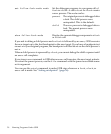marked to be
disabled or deleted
when hit.
Enabled or Disabled
Enabled
breakpoints are
marked with 'y'. 'n'
marks breakpoints
that are not
enabled.
Address
Where the
breakpoint is in
your program, as a
memory address.
What
Where the
breakpoint is in the
source for your
program, as a file
and line number.
If a breakpoint is conditional, info break shows
the condition on the line following the affected
breakpoint; breakpoint commands, if any, are
listed after that.
info break with a breakpoint number n as
argument lists only that breakpoint. The
convenience variable $_ and the default
examining-address for the x command are set to
the address of the last breakpoint listed (see
“Examining memory” (page 87)).
info break displays a count of the number of
times the breakpoint has been hit. This is especially
useful in conjunction with the ignore command.
You can ignore a large number of breakpoint hits,
look at the breakpoint info to see how many times
the breakpoint was hit, and then run again,
ignoring one less than that number. This will get
you quickly to the last hit of that breakpoint.
GDB allows you to set any number of breakpoints at the same place in your program.
There is nothing silly or meaningless about this. When the breakpoints are conditional,
this is even useful (see “Break conditions” (page 59).
5.1 Breakpoints 55


















